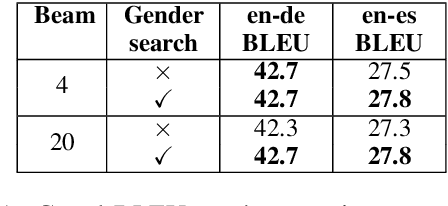First the worst: Finding better gender translations during beam search
Paper and Code
Apr 15, 2021



Neural machine translation inference procedures like beam search generate the most likely output under the model. This can exacerbate any demographic biases exhibited by the model. We focus on gender bias resulting from systematic errors in grammatical gender translation, which can lead to human referents being misrepresented or misgendered. Most approaches to this problem adjust the training data or the model. By contrast, we experiment with simply adjusting the inference procedure. We experiment with reranking nbest lists using gender features obtained automatically from the source sentence, and applying gender constraints while decoding to improve nbest list gender diversity. We find that a combination of these techniques allows large gains in WinoMT accuracy without requiring additional bilingual data or an additional NMT model.
 Add to Chrome
Add to Chrome Add to Firefox
Add to Firefox Add to Edge
Add to Edge